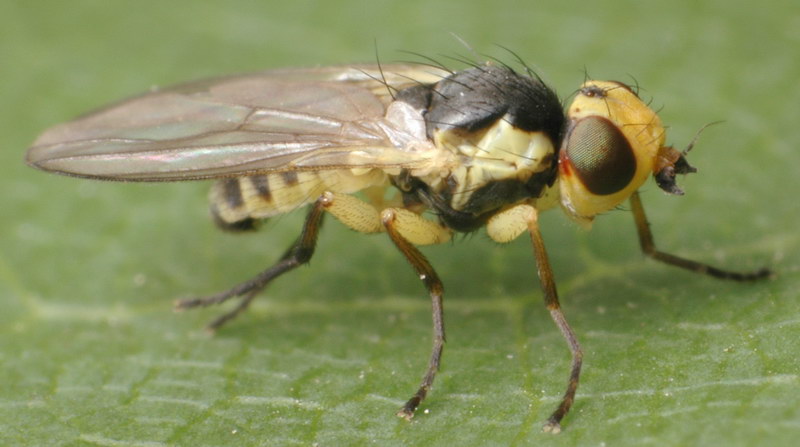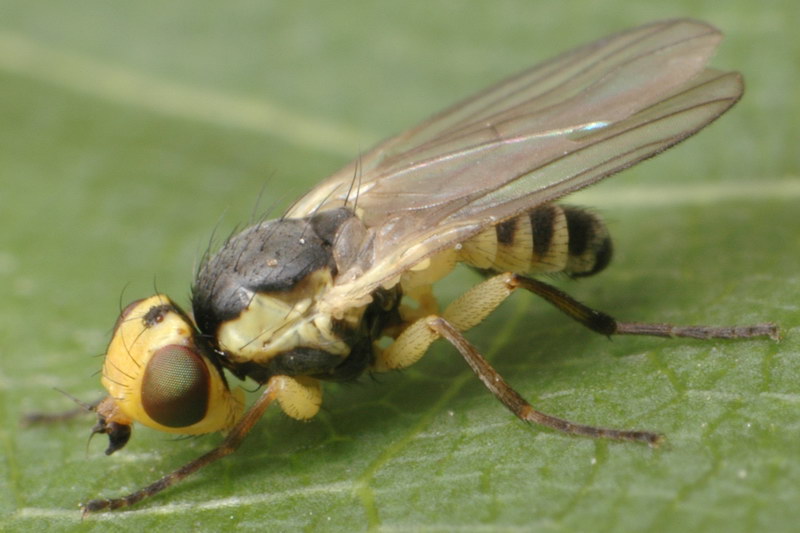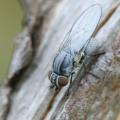Diptera.info :: Identification queries :: Diptera (adults)
Who is here? 1 guest(s)
|
One more Chloropidae
|
|
| Dmitry Gavryushin |
Posted on 03-07-2006 22:17
|
|
Member Location: Moscow region, Russia Posts: 3319 Joined: 17.10.05 |
July 01, 2006. Size 3-3.5mm. Dmitry Gavryushin attached the following image:  [87.49Kb] |
|
|
|
| Dmitry Gavryushin |
Posted on 03-07-2006 22:18
|
|
Member Location: Moscow region, Russia Posts: 3319 Joined: 17.10.05 |
Another view.
Dmitry Gavryushin attached the following image:  [100.29Kb] |
|
|
|
| Nikita Vikhrev |
Posted on 03-07-2006 22:59
|
|
Member Location: Moscow, Russia Posts: 9406 Joined: 24.05.05 |
I think it is Agromyzidae.
Nikita Vikhrev - Zool Museum of Moscow University |
|
|
|
| Nikita Vikhrev |
Posted on 03-07-2006 23:08
|
|
Member Location: Moscow, Russia Posts: 9406 Joined: 24.05.05 |
It looks that with this clear images I've come to Cerodontha lateralis, Agromyzidae.
Nikita Vikhrev - Zool Museum of Moscow University |
|
|
|
| Dmitry Gavryushin |
Posted on 04-07-2006 06:47
|
|
Member Location: Moscow region, Russia Posts: 3319 Joined: 17.10.05 |
Thanks Nikita, I think now it's time for me to learn to distinguish Chloropidae from Agromyzidae... |
|
|
|
| Paul Beuk |
Posted on 04-07-2006 08:11
|
|
Super Administrator Location: Netherlands Posts: 19403 Joined: 11.05.04 |
At least in this one it is clear that there is no large ocellar triangle.
Paul - - - - Paul Beuk on https://diptera.info |
| Nikita Vikhrev |
Posted on 04-07-2006 09:47
|
|
Member Location: Moscow, Russia Posts: 9406 Joined: 24.05.05 |
In modern checklists in genus Cerodontha there are much more species than in my key.
Nikita Vikhrev - Zool Museum of Moscow University |
|
|
|
| David Gibbs |
Posted on 04-07-2006 12:44
|
|
Member Location: Bristol, UK Posts: 833 Joined: 17.06.06 |
With such an extention to first flagellomere this must be Cerodontha subgenus Cerodontha (does it have one pair of scutellar bristles?). try using Nowakowski 1973, i suspect it will be in the C.affinis (Fall.) group but not one we have here in GB (unless it is a form of affinis with dark scutellum). I would not like to name these to species without dissection. |
|
|
|
| Nikita Vikhrev |
Posted on 04-07-2006 13:17
|
|
Member Location: Moscow, Russia Posts: 9406 Joined: 24.05.05 |
Hi David. 1. It is exatly what I meaned - species level ID of Agromyzidae, using key edited in 1970, has to be doubtfull. 2. On the other hand all description is absolutly for C. lateralis. For example, C. affinis has yellow scutellum and black abdomen with narrow yellow rings (C. laterralis - black, grey dusted thorax and scutellum, yellow abdomen with wide black rings, more wide in dorsal part). Nikita Nikita Vikhrev - Zool Museum of Moscow University |
|
|
|
| David Gibbs |
Posted on 04-07-2006 16:27
|
|
Member Location: Bristol, UK Posts: 833 Joined: 17.06.06 |
but lateralis (Macq) is in subgenus Poemyza (4 scutellar bristles, small round ist flagellomere). I am not saying your fly is affinis, just that it is close, affinis does indeed have some yellow on scutellum. looking more closely through Nowakowski and at your photo i think it is a species not in that key, ie described since 1973 or an undescribed species. |
|
|
|
| Paul Beuk |
Posted on 04-07-2006 19:45
|
|
Super Administrator Location: Netherlands Posts: 19403 Joined: 11.05.04 |
Let's bring it all together now: This species is Cerodontha (Cerodontha) hennigi. It was originally described as Chlorops lateralis by Zetterstedt in 1848. However, there is another species in Cerodontha known under the name lateralis (in Cerodontha (Poemyza), described by Macquart in 1835). As long as both species remain placed in Cerodontha, the lateralis name by Zetterstedt cannot be used and the correct name then is hennig Nowakowski, 1967. Paul - - - - Paul Beuk on https://diptera.info |
| Nikita Vikhrev |
Posted on 04-07-2006 21:31
|
|
Member Location: Moscow, Russia Posts: 9406 Joined: 24.05.05 |
Thank you Paul.
Nikita Vikhrev - Zool Museum of Moscow University |
|
|
|
| Jump to Forum: |















